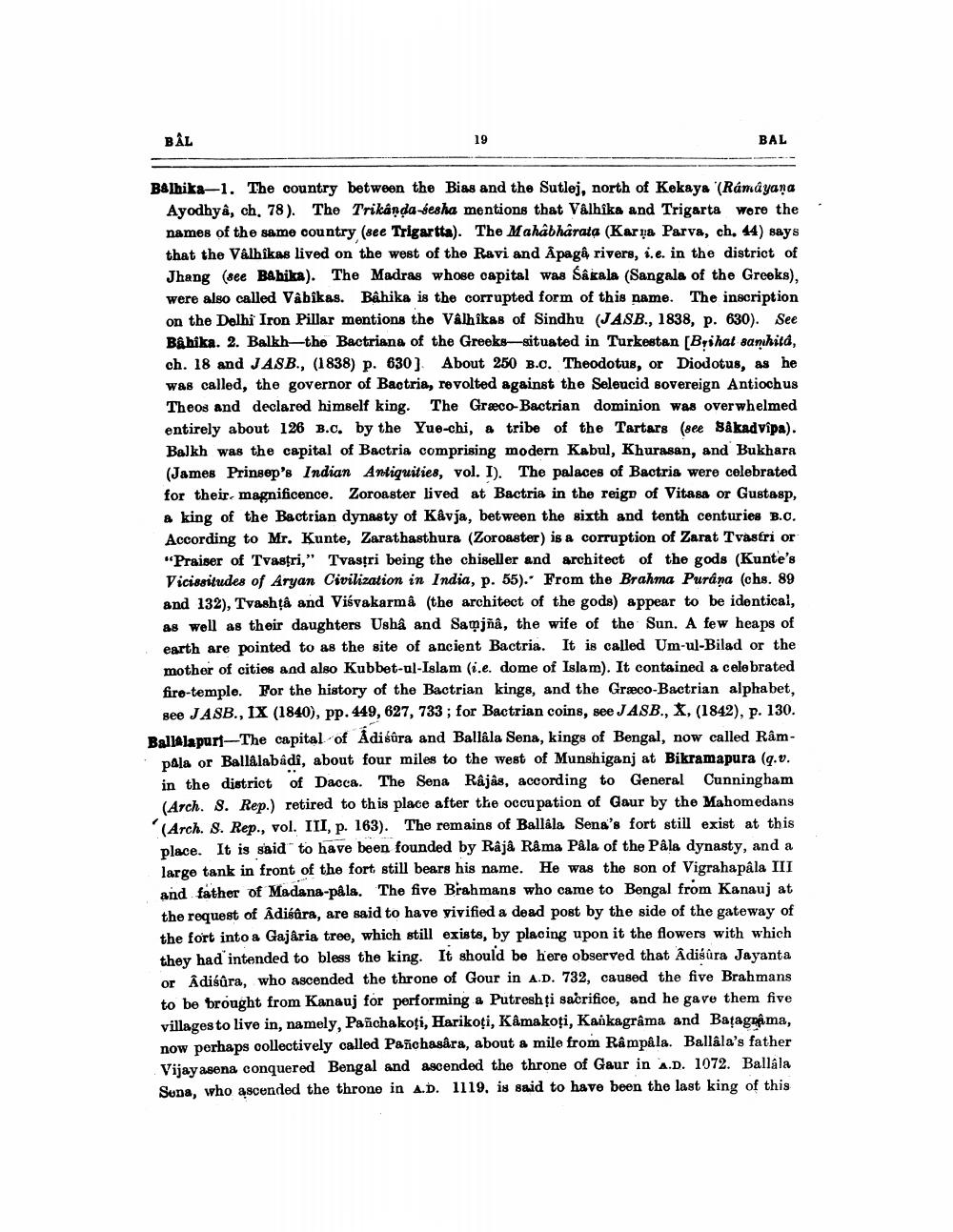________________
BÂL
BAL
Belhika-1. The country between the Bias and the Sutlej, north of Kekaya (Ramayana
Ayodhyâ, ch, 78). The Trikânda-sesha mentions that Válhika and Trigarta were the names of the same country (see Trigartta). The Mahabharata (Karna Parva, ch, 44) says that the VAlhikas lived on the west of the Ravi and Åpagâ rivers, i.e. in the district of Jhang (see BAhika). The Madras whose capital was Sakala (Sangala of the Greeks). were also called Vabikas. Bâhika is the corrupted form of this name. The inscription on the Delhi Iron Pillar mentions the Válhikas of Sindhu (JASB., 1838, p. 630). See Bahika. 2. Balkh-the Bactriana of the Greeks-situated in Turkestan [Brihat sanhita, ch. 18 and JASB., (1838) p. 630 ) About 250 B.C. Theodotus, or Diodotus, as he was called, the governor of Bactria, revolted against the Seleucid sovereign Antiochus Theos and declared himself king. The Græco-Bactrian dominion was overwhelmed entirely about 126 B.C. by the Yue-chi, & tribe of the Tartars (see såkadvipa). Baðkh was the capital of Bactria comprising modern Kabul, Khurasan, and Bukhara (James Prinsep's Indian Antiquities, vol. 1). The palaces of Bactria were celebrated for their magnificence. Zoroaster lived at Bactria in the reign of Vitasa or Gustasp, & king of the Bactrian dynasty of Kâvja, between the sixth and tenth centuries B.C. According to Mr. Kunte, Zarathasthura (Zoroaster) is a corruption of Zarat Tvåstri or "Praiser of Tvastri," Tvastri being the chiseller and architect of the gods (Kunte's Vicissitudes of Aryan Civilization in India, p. 55). From the Brahma Purana (chs. 89 and 132), Tvashțâ and Viśvakarma (the architect of the gods) appear to be identical, as well as their daughters Usha and Samjña, the wife of the Sun. A few heaps of earth are pointed to as the site of ancient Bactria. It is called Um-ul-Bilad or the mother of cities and also Kubbet-ul-Islam (i.e. dome of Islam). It contained a celebrated fire-templo. For the history of the Bactrian kings, and the Greco-Bactrian alphabet. see JASB., IX (1840), pp. 449, 627, 733; for Bactrian coins, see JASB., X, (1842), p. 130. Ballalapurt-The capital of Adigūra and Ballkla Sena, kings of Bengal, now called Râm
pila or BallAlabâdi, about four miles to the west of Munshiganj at Bikramapura (g.v. in the district of Dacca. The Sena Râjâs, according to General Cunningham (Arch. 8. Rep.) retired to this place after the occupation of Gaur by the Mahomedans (Arch. 8. Rep., vol. III, p. 163). The remains of Ballála Sena's fort still exist at this place. It is said to have been founded by Râjâ Râma Pala of the Pâla dynasty, and a large tank in front of the fort still bears his name. He was the son of Vigrahapala III and father of Madana-pala. The five Brahmans who came to Bengal from Kanauj at the request of Adisāra, are said to have vivified a dead post by the side of the gateway of the fort into a Gajaria tree, which still exists, by placing upon it the flowers with which they had' intended to bless the king. It should be here observed that Adigūra Jayanta or Adisūra, who ascended the throne of Gour in A.D. 732, caused the five Brahmans to be brought from Kanauj for performing a Putreshți sacrifice, and he gave them five villages to live in, namely, Paichakoţi, Harikoţi, Kamakoti, Kankagrama and Batagema, now perhaps collectively called Panichasåra, about a mile from Râmpala. Ballâla's father Vijayasena conquered Bengal and ascended the throne of Gaur in A.D. 1072. Ballála Suna, who ascended the throne in A.D. 1119, is said to have been the last king of this




